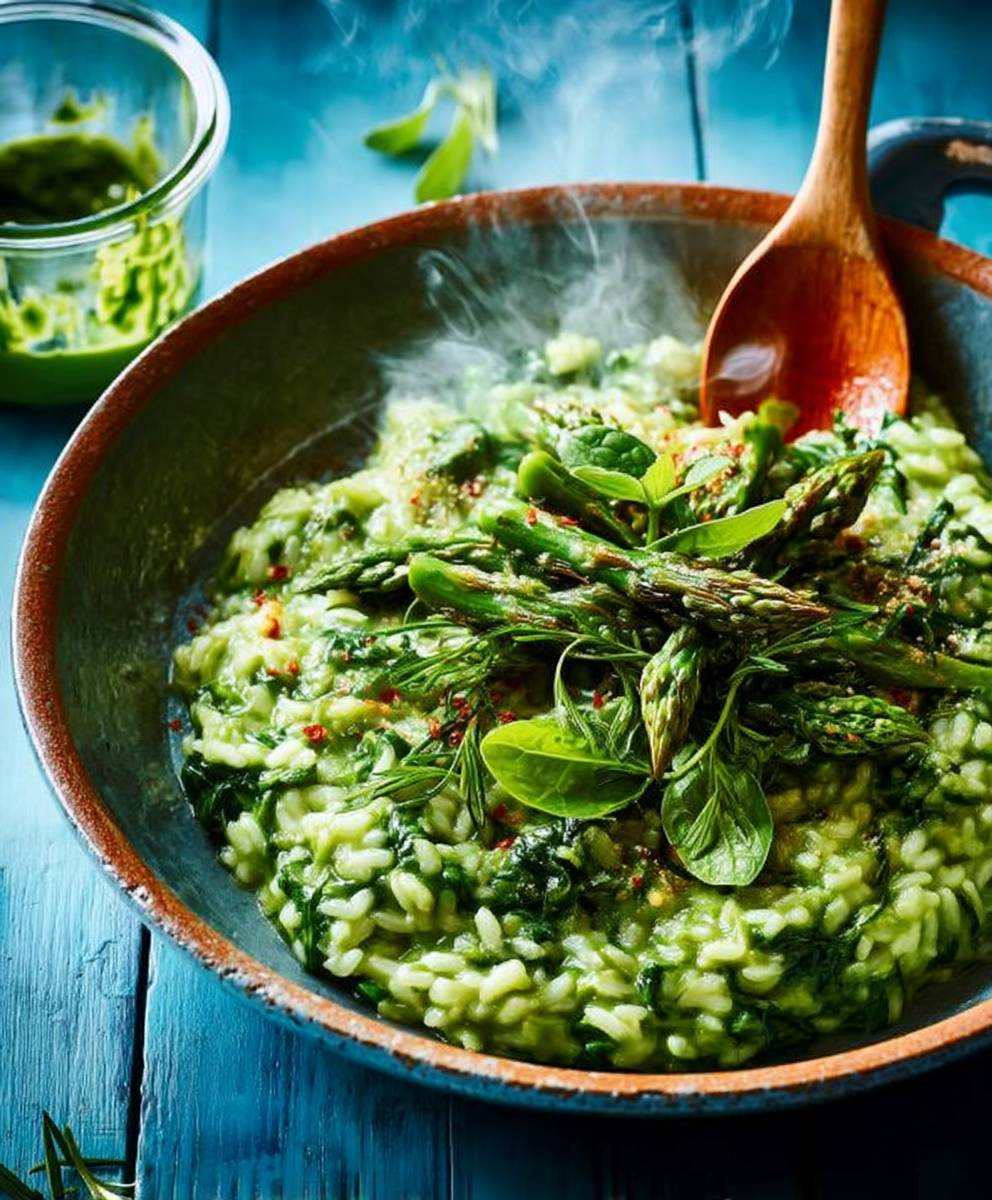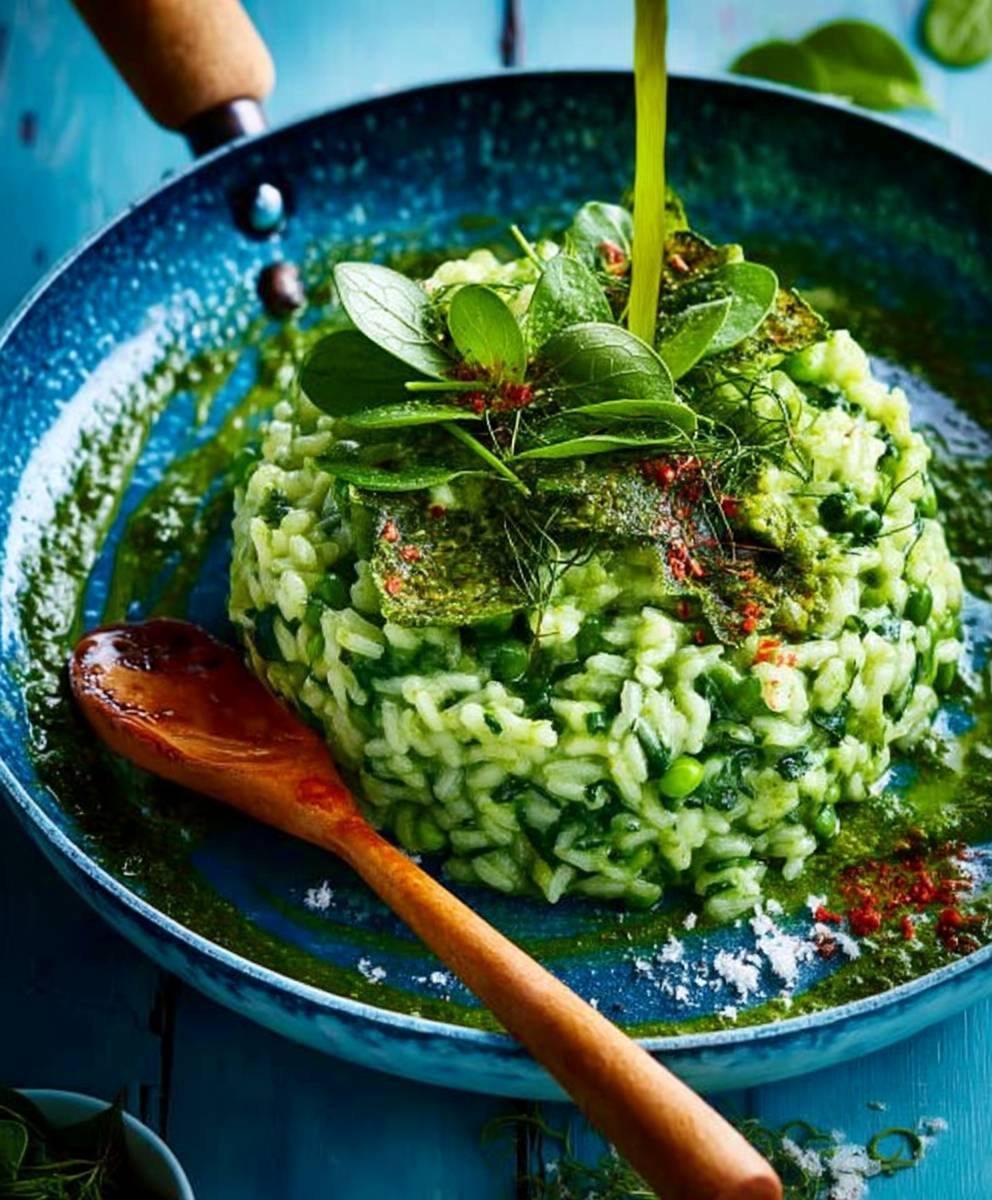Green vegetable risotto: Prepare to be transported to the heart of Italy with this vibrant and utterly delicious dish! Imagine a creamy, comforting bowl of risotto, bursting with the fresh flavors of spring. This isn’t just any risotto; it’s a celebration of green goodness, a symphony of textures and tastes that will leave you craving more.
Risotto, a northern Italian staple, has a rich history dating back to the 14th century. Legend has it that a young apprentice, using saffron to color glass for the Duomo di Milano, added it to a rice dish, inadvertently creating the first risotto alla Milanese. Over the centuries, risotto has evolved, embracing countless variations, each reflecting the unique ingredients and culinary traditions of its region. Our green vegetable risotto pays homage to this heritage, showcasing the versatility and adaptability of this beloved dish.
But what is it about risotto that captivates food lovers worldwide? It’s the perfect marriage of creamy texture and al dente rice, a comforting embrace in every spoonful. The subtle sweetness of the vegetables, combined with the savory broth and Parmesan cheese, creates a flavor profile that is both sophisticated and satisfying. Plus, its a fantastic way to sneak in those extra greens! Whether you’re looking for a comforting weeknight meal or an elegant dish to impress your guests, this recipe is sure to become a new favorite.
Ingredients:
- 1 tablespoon olive oil
- 1 medium onion, finely chopped
- 2 cloves garlic, minced
- 1 1/2 cups Arborio rice
- 1/2 cup dry white wine (optional)
- 6 cups hot vegetable broth, preferably homemade
- 1 cup chopped asparagus (about 1/2 pound)
- 1 cup chopped zucchini (about 1 medium)
- 1 cup frozen peas, thawed
- 1/2 cup chopped fresh spinach
- 1/4 cup grated Parmesan cheese, plus more for serving
- 2 tablespoons butter
- Salt and freshly ground black pepper to taste
- Optional garnish: fresh parsley, lemon zest
Preparing the Vegetables and Broth
Before we even think about touching the rice, let’s get our vegetables prepped and ready to go. This is crucial because risotto is all about timing, and you don’t want to be scrambling to chop veggies while your rice is burning!
- Chop the onion and garlic: Finely chop the onion. You want it small enough that it melts into the risotto and doesn’t provide a chunky texture. Mince the garlic I like to use a garlic press for this, but finely chopping it with a knife works just as well.
- Prepare the asparagus and zucchini: Wash and trim the asparagus, discarding the tough ends. Chop the asparagus into 1-inch pieces. Wash the zucchini and chop it into similar-sized pieces. Consistency in size will ensure even cooking.
- Thaw the peas: If you’re using frozen peas (which I usually do because they’re so convenient), make sure to thaw them before adding them to the risotto. You can simply place them in a bowl of cold water for a few minutes, or let them sit at room temperature.
- Chop the spinach: Give the spinach a good wash and chop it roughly. It will wilt down considerably during cooking, so don’t worry about making it too fine.
- Heat the vegetable broth: This is a really important step! Keep the vegetable broth hot in a saucepan over low heat. Using cold broth will drastically lower the temperature of the rice and disrupt the cooking process, leading to unevenly cooked risotto. I usually use a separate burner for this. You can even use a slow cooker to keep it consistently hot.
Cooking the Risotto
Now for the main event! This is where the magic happens. Risotto requires a bit of attention, but trust me, the creamy, flavorful result is well worth the effort. Don’t be intimidated just follow these steps and you’ll be a risotto pro in no time!
- Sauté the onion and garlic: In a large, heavy-bottomed pot or Dutch oven, heat the olive oil over medium heat. Add the chopped onion and cook until softened and translucent, about 5-7 minutes. Be careful not to brown the onion. Add the minced garlic and cook for another minute, until fragrant.
- Toast the rice: Add the Arborio rice to the pot and stir constantly for 2-3 minutes, until the grains are lightly toasted and translucent around the edges. This step is crucial for developing the nutty flavor of the risotto and helps prevent it from becoming mushy. You should hear a slight crackling sound as the rice toasts.
- Deglaze with white wine (optional): If you’re using white wine, pour it into the pot and stir until it’s completely absorbed by the rice. This will add a lovely depth of flavor to the risotto. If you’re not using wine, simply skip this step and move on to adding the broth.
- Add the broth gradually: This is the key to perfect risotto! Add about 1 cup of the hot vegetable broth to the rice and stir constantly until it’s almost completely absorbed. The rice should be simmering gently, not boiling vigorously.
- Continue adding broth: Continue adding the broth, one cup at a time, stirring constantly and allowing each addition to be almost completely absorbed before adding the next. This process will take about 20-25 minutes. The constant stirring releases the starch from the rice, creating the creamy texture that risotto is known for.
- Test for doneness: After about 20 minutes, start testing the rice for doneness. The risotto should be creamy and slightly al dente, meaning it should have a slight bite to it. The grains should be tender but not mushy.
- Incorporate the green vegetables: Once the rice is almost cooked, add the chopped asparagus and zucchini. Stir well and cook for another 5 minutes, or until the vegetables are tender-crisp.
- Add the peas and spinach: Stir in the thawed peas and chopped spinach. Cook for another 2-3 minutes, until the peas are heated through and the spinach has wilted.
- Stir in the cheese and butter: Remove the pot from the heat and stir in the grated Parmesan cheese and butter. This will add richness and creaminess to the risotto.
- Season to taste: Season the risotto with salt and freshly ground black pepper to taste. Be generous with the pepper!
Serving and Garnishing
The final touch! Now that your risotto is perfectly cooked, it’s time to serve it up and enjoy the fruits (or rather, vegetables) of your labor.
- Serve immediately: Risotto is best served immediately, as it will continue to thicken as it cools.
- Garnish (optional): Garnish with a sprinkle of fresh parsley and a grating of lemon zest for a pop of color and flavor.
- Serve with extra Parmesan: Offer extra Parmesan cheese at the table for those who want to add even more cheesy goodness.
Tips for Perfect Risotto
- Use the right rice: Arborio rice is the classic choice for risotto because of its high starch content, which creates the creamy texture. Carnaroli rice is another good option, as it’s even starchier than Arborio.
- Don’t rinse the rice: Rinsing the rice will remove the starch, which is essential for creating the creamy texture of risotto.
- Use hot broth: As mentioned earlier, using hot broth is crucial for maintaining the temperature of the rice and ensuring even cooking.
- Stir constantly: Stirring constantly releases the starch from the rice and prevents it from sticking to the bottom of the pot.
- Don’t overcook the rice: The risotto should be creamy and slightly al dente, not mushy.
- Adjust the broth as needed: You may need to use more or less broth depending on the type of rice you use and the heat of your stove.
- Get creative with the vegetables: Feel free to experiment with different green vegetables, such as broccoli, green beans, or kale.
- Make it vegan: To make this risotto vegan, simply substitute the Parmesan cheese with nutritional yeast and use vegan butter.
Troubleshooting Risotto
- Risotto is too dry: If the risotto is too dry, add a little more hot broth and stir until it’s absorbed.
- Risotto is too wet: If the risotto is too wet, continue cooking it over low heat, stirring constantly, until the excess liquid has evaporated.
- Rice is undercooked: If the rice is still hard after 25 minutes, add a little more hot broth and continue cooking, stirring constantly, until it’s tender.
- Rice is overcooked: If the rice is mushy, unfortunately, there’s not much you can do. Be more careful next time!

Conclusion:
This isn’t just another risotto recipe; it’s a vibrant, flavorful experience that will transform your perception of what a truly great risotto can be. The creamy texture, the bright, fresh taste of the green vegetables, and the subtle hint of Parmesan cheese all come together in perfect harmony. I truly believe this green vegetable risotto is a must-try for anyone who appreciates good food, whether you’re a seasoned chef or a beginner in the kitchen. It’s surprisingly easy to make, and the results are guaranteed to impress.
But the best part? It’s incredibly versatile! While I’ve outlined my favorite combination of green vegetables asparagus, peas, and spinach feel free to experiment with what’s in season or what you have on hand. Broccoli florets, zucchini, green beans, or even kale would all be delicious additions or substitutions. For a richer flavor, try using vegetable broth infused with herbs like thyme or rosemary. And if you’re feeling adventurous, a squeeze of lemon juice at the end adds a delightful zing that cuts through the richness of the risotto.
Serving Suggestions and Variations:
* As a Main Course: Serve a generous portion of the risotto as a satisfying and healthy main course. A sprinkle of extra Parmesan cheese and a drizzle of olive oil will elevate the presentation.
* As a Side Dish: This risotto makes a wonderful accompaniment to grilled chicken, fish, or even a hearty steak. Its vibrant color and fresh flavor will complement any protein.
* For a Vegan Option: Simply omit the Parmesan cheese and use a vegan-friendly vegetable broth. You can also add a tablespoon of nutritional yeast for a cheesy flavor.
* Add Some Protein: For a more substantial meal, consider adding grilled shrimp, pan-seared scallops, or even some crumbled Italian sausage to the risotto.
* Make it Spicy: A pinch of red pepper flakes or a dash of your favorite hot sauce will add a welcome kick to the risotto.
* Elevate with Truffle: A drizzle of truffle oil or a shaving of fresh truffle (if you’re feeling fancy!) will transform this risotto into a truly decadent dish.
I’m so excited for you to try this recipe! I know you’ll love the creamy texture, the fresh flavors, and the overall simplicity of making this green vegetable risotto. It’s a dish that’s perfect for a weeknight dinner, a special occasion, or even a casual gathering with friends.
Don’t be afraid to get creative and put your own spin on it. Cooking should be fun and experimental, so feel free to adjust the ingredients and seasonings to your liking. The most important thing is to enjoy the process and create a dish that you truly love.
Once you’ve tried this recipe, I would absolutely love to hear about your experience! Share your photos and comments on social media using [Your Hashtag Here] or leave a review on my website. I’m always eager to see how others are enjoying my recipes and to learn from your feedback. Happy cooking, and bon appétit! I can’t wait to see your beautiful, vibrant, and delicious creations of this green vegetable risotto! Let me know what variations you try and what your family and friends think!
Green Vegetable Risotto: A Delicious & Healthy Recipe
Creamy, flavorful Spring Vegetable Risotto with asparagus, zucchini, peas, and spinach. A comforting and vibrant dish.
Ingredients
- 1 tablespoon olive oil
- 1 medium onion, finely chopped
- 2 cloves garlic, minced
- 1 1/2 cups Arborio rice
- 1/2 cup dry white wine (optional)
- 6 cups hot vegetable broth, preferably homemade
- 1 cup chopped asparagus (about 1/2 pound)
- 1 cup chopped zucchini (about 1 medium)
- 1 cup frozen peas, thawed
- 1/2 cup chopped fresh spinach
- 1/4 cup grated Parmesan cheese, plus more for serving
- 2 tablespoons butter
- Salt and freshly ground black pepper to taste
- Optional garnish: fresh parsley, lemon zest
Instructions
- Chop the onion and garlic: Finely chop the onion. Mince the garlic.
- Prepare the asparagus and zucchini: Wash and trim the asparagus, discarding the tough ends. Chop the asparagus into 1-inch pieces. Wash the zucchini and chop it into similar-sized pieces.
- Thaw the peas: Thaw the frozen peas.
- Chop the spinach: Wash and roughly chop the spinach.
- Heat the vegetable broth: Keep the vegetable broth hot in a saucepan over low heat.
- Sauté the onion and garlic: In a large, heavy-bottomed pot or Dutch oven, heat the olive oil over medium heat. Add the chopped onion and cook until softened and translucent, about 5-7 minutes. Add the minced garlic and cook for another minute, until fragrant.
- Toast the rice: Add the Arborio rice to the pot and stir constantly for 2-3 minutes, until the grains are lightly toasted and translucent around the edges.
- Deglaze with white wine (optional): If using, pour the white wine into the pot and stir until it’s completely absorbed by the rice.
- Add the broth gradually: Add about 1 cup of the hot vegetable broth to the rice and stir constantly until it’s almost completely absorbed.
- Continue adding broth: Continue adding the broth, one cup at a time, stirring constantly and allowing each addition to be almost completely absorbed before adding the next. This process will take about 20-25 minutes.
- Test for doneness: After about 20 minutes, start testing the rice for doneness. The risotto should be creamy and slightly al dente.
- Incorporate the green vegetables: Once the rice is almost cooked, add the chopped asparagus and zucchini. Stir well and cook for another 5 minutes, or until the vegetables are tender-crisp.
- Add the peas and spinach: Stir in the thawed peas and chopped spinach. Cook for another 2-3 minutes, until the peas are heated through and the spinach has wilted.
- Stir in the cheese and butter: Remove the pot from the heat and stir in the grated Parmesan cheese and butter.
- Season to taste: Season the risotto with salt and freshly ground black pepper to taste.
- Serve immediately: Risotto is best served immediately.
- Garnish (optional): Garnish with a sprinkle of fresh parsley and a grating of lemon zest.
- Serve with extra Parmesan: Offer extra Parmesan cheese at the table.
Notes
- Use Arborio rice for the best creamy texture.
- Don’t rinse the rice, as the starch is essential.
- Keep the broth hot throughout the cooking process.
- Stir constantly to release starch and prevent sticking.
- Adjust broth amount as needed based on rice and stove heat.
- Get creative with other green vegetables.
- Make it vegan by substituting Parmesan with nutritional yeast and using vegan butter.






Leave a Comment